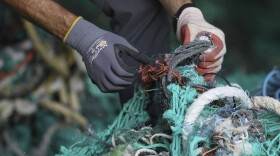The state Department of Health has redesigned its contact tracing program with a new leader to adapt to the surge in COVID-19 cases. It's too soon to tell if the changes will be enough to contain the virus but the program will be closely watched.
When the state began reopening this summer, and COVID-19 cases surged again in August, media reports, including those from HPR, highlighted the health department’s weak contact tracing program.
“I was not aware of any plan,” said Jennifer Smith, an epidemiology specialist at the DOH. She is now on paid leave after blowing the whistle on the state’s contact tracing deficiencies.
She explained that when the state first locked down in March and June to slow the spread of COVID-19, she was unaware of any plan to increase contact tracers from a handful of staff.
“I think that time was lost,” said Smith. "I think there were discussions on what we need to do and where we could pull people from, but even in May it was just discussion.”
However, four months later, the city locked down for a second time because of the surge in COVID-19 cases.
Since then, and in the wake of rising criticism of the health department's COVID response, there has been a shakeup in leadership. Emily Roberson, an epidemiologist has replaced state epidemiologist Sarah Park and is now leading the state’s contact tracing. Health Director Bruce Anderson will retire today. His interim replacement is Dr. Libby Char, an emergency room physician.
Roberson has restructured the contact program and hired more people. As a result, she said her staff has been able to reach out to 100% of those who received a positive COVID-19 test result.
However, for various reasons, the state was only able to talk to about 50% of those they call.
Roberson said the missed connections could be because a person did not pick up the phone, or investigators were given incorrect contact information from the labs.
Once people are contacted, the department prioritizes those at highest risk-- such as those with severe cases -- and reaches out to them first.
“[We’re] prioritizing the cases based on risk factor, one would be the individuals who test positive spreading it to others,” Roberson said.
“This really would lead us to focus on high-risk occupations. This is high risk not meaning just that the individuals themselves are at risk for poorer outcomes, but that they are at risk of spreading it to others due to the nature of their occupation.”
Roberson created special investigation teams, including those who can best contact trace higher risk populations in schools, healthcare, restaurants and correctional facilities.
She explained that it’s a new way of trying to contact trace despite Hawaii’s high case load. She noted that states in similar situations have abandoned contact tracing until their cases can be contained.
“Contact tracing is a containment strategy, not a mitigation strategy,” Roberson said.
Mitigation is when case loads are high -- a phase Hawaii is in now.
“The utility of contract tracing when you’re in a mitigation stage phase is limited, whereas when you're in a containment phase, that’s when contact tracing tends to shine. The specialized investigation team, those are a novel approach to using contact tracing in order to achieve large and rapid results,” Roberson said.
Her plan calls for assigning four roles to about 250 people at the Department of Health, some of whom are contact tracing part of the week.
The roles include case investigation, contact tracing, case monitoring and close contact monitoring. Previously, all this was conducted by about 10 epidemiology specialists.
Roberson said the new structure allows the highly trained epidemiology specialists to focus on the initial case investigation with a positive patient, the most complicated part of the process.
Other staff call and monitor the positive patient’s close contacts.
East-West Center Infectious Disease expert Tim Brown said the test of whether Roberson’s new contact tracing program is working will be the data that comes out after the city’s lockdown is lifted -- when cases may again spike.
“I would really like to see metrics that say they are reaching everybody within 24 hours, if not even the same afternoon when we get a diagnosis. That they stood up some of these electronic systems, that they're actually following up on people who are in quarantine to make sure that they are adhering to quarantine, that they're getting daily check-in in terms of symptoms and other issues,” he said.
“Those are the things that are part of contact tracing that have definitely not been done today. And that's why we need metrics that measure those things so that we can tell that they're actually happening.”
Roberson said she'll know if she's been successful when more people with COVID have been contacted and the data on cases that weren't gathered before are collected and made public.




